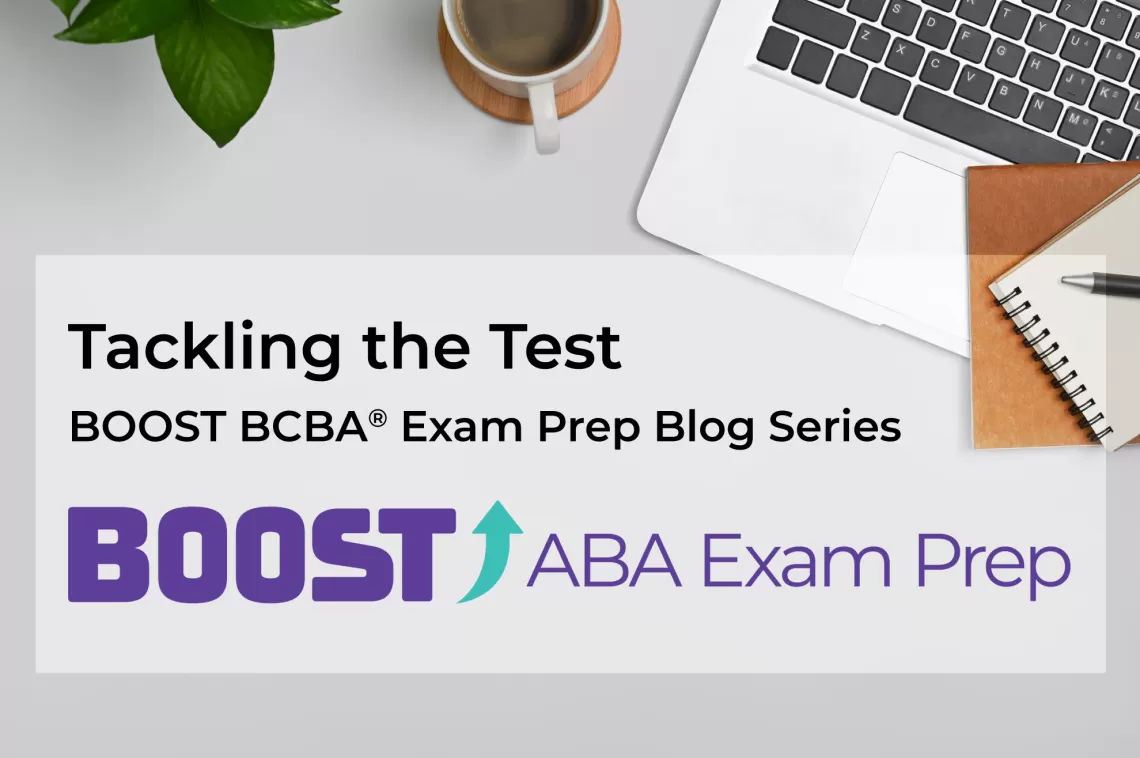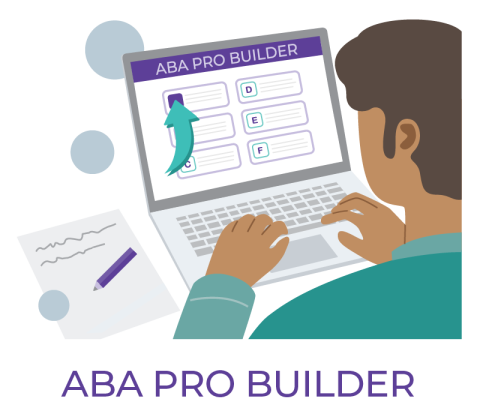
6 Ways to BOOST Your Study Time - Tackling the Test Series
Part 7
Part 1: Intro to the Series
Part 2: First Steps for Preparing for the BACB® Exam
Part 3: Mock Exams for BCBA® Exam Prep
Part 4: Self-Management Strategies for BCBA® Exam Prep
Part 5: Study Methods that Work
Part 6: Beyond Rote Memorization
Part 7: 6 Ways to BOOST Your Study Time
Part 8: 10 Ways Your Friends and Family Can Help You Study for the BCBA® Exam
Part 9: Test-taking Strategies for the BCBA® Exam
Part 10: Conquering Test Anxiety with Behavioral Science
"To practice is to declare I can be better." —Dan Heath
There is a popular saying, “You are what you eat.”
This short sentence conveys that physical health greatly depends on what you put into your body. Similarly, we could say, “You do what you practice.” In other words, deliberately practicing the skills you need to develop when you study can make that time more productive. Practicing key skills in the right context increases your chances of performing those skills under similar conditions.
But this kind of deliberate practice doesn’t happen by accident. It demands careful selection and sequencing of content, along with effective self-management strategies. Lack of planning or direction will likely result in a decrease in progress, which can be described as “being in a study rut.” Following are six strategies you can use to optimize your study time.
1. Create the Right Conditions
 One common misconception about behavior is that it is determined by internal events. That is, you need to wait for motivation to arrive to get out of a study rut—the same way an artist would wait for their muse to inspire them to engage in their craft.
One common misconception about behavior is that it is determined by internal events. That is, you need to wait for motivation to arrive to get out of a study rut—the same way an artist would wait for their muse to inspire them to engage in their craft.
Fortunately, this is not the case. Motivation is harnessed by creating the right conditions for behavior. If you place exam study materials on a desk in your office and dedicate an hour each morning to study at that desk without distractions, you are more likely to have a productive study session. Likewise, if you make a highly enjoyable activity dependent on completing a less preferred activity, it can increase motivation and engagement towards the less enjoyable task. This is why discipline and creating good habits are so important.
To create the right conditions to study, remove all non-study materials from the location where you would like to study. These distractors are likely to compete with study behavior. Turn off your phone and anything else that might divert your attention during scheduled study sessions. Next, gather all study materials relevant to the area you need to practice—books, handouts, study flashcards, notes, paper, and pencils. Don’t forget a timer. It will be important to record your progress over time.
2. Designate Brief Periods to Study
If you study for long periods, you are likely to get fatigued and lose focus. To avoid unproductive periods, take breaks every 45 minutes. Remember, quality is more important than quantity when you practice. So, make those 45-minutes count.
Taking frequent breaks can also be motivating and make studying less daunting. Use breaks to do something you enjoy, like drinking coffee, playing guitar, or playing with your dog. This might seem unproductive in the short term, but it sustains practice over time.
3. Isolate the Skills
 Now, it’s time to identify what you need to study effectively. This shouldn't be too difficult if you are a behavior analyst studying for the certification exam. The BACB® Task List provides the content you should focus on. If you have taken well-designed courses in behavior analysis, you should have a list of learning objectives identifying the skills targeted for instruction. Use these resources to organize your materials. Note the learning objectives that align with the BACB® Task List Or Test Content Outline. In addition, consider the chapters, slides, study flashcards, examples, or exam prep exercises that support each learning objective.
Now, it’s time to identify what you need to study effectively. This shouldn't be too difficult if you are a behavior analyst studying for the certification exam. The BACB® Task List provides the content you should focus on. If you have taken well-designed courses in behavior analysis, you should have a list of learning objectives identifying the skills targeted for instruction. Use these resources to organize your materials. Note the learning objectives that align with the BACB® Task List Or Test Content Outline. In addition, consider the chapters, slides, study flashcards, examples, or exam prep exercises that support each learning objective.
To find additional resources, list multiple ways you can demonstrate a skill—this is known as “learning channels” in Precision Teaching. Analyze how you might experience an opportunity to demonstrate a skill (“ins”). For example, will you read a question on your computer or hear someone presenting an instruction? Or, perhaps you see another person acting in a certain way, and you will need to respond. Then, take some time to think about how you will need to respond when those opportunities are present (“outs”). For example, will you need to point, click with a mouse, demonstrate an action, draw, mark on a piece of paper, match items, or say or write an answer? For each opportunity, list all possible ways in which you could respond. If you read a scenario, you could practice saying, writing, demonstrating a relevant action, and drawing the answer. Interspersing different repertoires can strengthen learning by integrating skills and keeping you engaged.
Dr. Joe Layng offers some great advice to students on how to read textbooks:
- Browse through a relevant chapter without reading the content. Notice titles and subtitles defining each section. Pay attention to how the material builds up.
- Correlate sections of the text with groups of assigned problems. If the problems appear at the back of the book, identify which problems are from which section.
- Work through the examples in the text when they are presented. Cover any answers provided so you can work out the answer independently. Uncover the provided answers for feedback on your solutions. Repeat this step, if needed, until you can provide the correct response.
- Work on a correlated group of questions before moving on to the next section in the textbook. Mastering a section will help with the material covered in subsequent sections. Practice with new examples to demonstrate the application of the skill.
4. Record Your Progress
 A critical and often overlooked component in self-management is recording your progress. Self-monitoring consists of measuring desired performance. Dedicate at least one minute daily to count how many correct answers you can provide during that period. Gather your timer and any materials needed to practice (the learning channels’ “ins” and “outs” identified in step 3) and respond as accurately and quickly as possible. Mix skills from different areas in this timed practice. This will give you a measure of fluency, which is essential to mastering any skill.
A critical and often overlooked component in self-management is recording your progress. Self-monitoring consists of measuring desired performance. Dedicate at least one minute daily to count how many correct answers you can provide during that period. Gather your timer and any materials needed to practice (the learning channels’ “ins” and “outs” identified in step 3) and respond as accurately and quickly as possible. Mix skills from different areas in this timed practice. This will give you a measure of fluency, which is essential to mastering any skill.
Notice any mistakes you make. You should spend additional time reviewing those skills and finding more practice opportunities. This will allow you to focus on those areas where you need to make progress. Make sure you graph your measure of performance for the day. This graph will give you invaluable feedback on your progress and show whether you need adjustments.
5. Real Life Practice
Try to recreate the conditions where you will need to perform the skills as much as possible. For example, if you are studying to take an exam, will you be taking the exam while sitting at a desk? Will you be using a computer or writing answers on paper? Or will you need to demonstrate a skill in a specific context? Practicing skills under similar conditions increases the likelihood that you will perform well when it counts.
If relevant, work with a supervisor, colleague, family member, or friend to practice demonstrating the skill in real-life scenarios or during role play. Go out of the study environment and practice the skill in new contexts.
6. Celebrate Improvement
Finally, make sure you share your progress with others and celebrate gradual improvements in performance. Surround yourself with people who share similar goals and support each other. Reward yourself with a favorite treat or activity when you achieve short- and long-term goals.
We have provided some practical steps you might find helpful when experiencing a study rut. Remember, behavior change is a gradual process that takes time and requires persistence and ways to measure progress. It’s important to set clear goals, establish the right conditions, and recruit a supportive environment.
"You can practice shooting eight hours a day, but if your technique is wrong, then all you become is very good at shooting the wrong way."
—Michael Jordan
BOOST ABA Pro Builder is available now!

